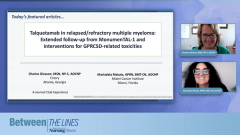
Updated Safety Profile of Talquetamab & Concluding Thoughts from MonumenTAL-1
Panelists discuss updated safety findings from GPRC5D-targeted bispecific therapy in relapsed/refractory multiple myeloma, highlighting manageable toxicity—including low infection rates and infrequent neurologic effects like ataxia—alongside sustained efficacy and durability, reinforcing its value as a well-tolerated option for patients ineligible for or resistant to BCMA-directed treatments.
Episodes in this series

The updated safety analysis of GPRC5D-targeted bispecific therapy continues to reinforce its favorable toxicity profile, particularly when compared to other bispecific agents. As expected, cytokine release syndrome and GPRC5D-related oral and dermatologic side effects remained the most commonly observed treatment-related adverse events. Importantly, there were no new discontinuations reported in this latest data, and the majority of grade 3 or 4 adverse events were cytopenias. Infection rates, a major concern with T-cell–redirecting therapies, remained notably low—even in patients who were heavily pretreated—especially compared with B-cell maturation antigen (BCMA)–targeted bispecific antibodies.
A new safety signal observed in this follow-up was the emergence of ataxia or balance issues in some patients. Although this represents a potential neurologic adverse effect to monitor, overall rates of dose reduction and treatment discontinuation remained low, and critically, no treatment-related deaths were reported. These findings are encouraging, particularly as they suggest that adverse effects are largely manageable and do not frequently necessitate stopping therapy, which is essential for maintaining durable responses.
The investigators concluded that talquetamab continues to show strong clinical benefit at a median follow-up of 30 to 38 months. High overall response rates, impressive durability of responses, and encouraging 36-month overall survival rates were observed even in patients with extensive prior therapies. The low rate of serious infections, in contrast with some other bispecific agents, may contribute to this survival benefit. Taken together, the consistent safety and efficacy outcomes support the role of GPRC5D-targeted therapy as a valuable option in the evolving treatment landscape for relapsed/refractory multiple myeloma, especially for patients who are not candidates for BCMA-directed treatments or have previously failed them.
Newsletter
Knowledge is power. Don’t miss the most recent breakthroughs in cancer care.


















































































